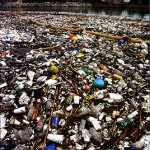Well, it's finally time to write what I have been putting off for no good reason. I think of myself as someone pretty environmentally aware and conscious, and like most people, I had heard that, "There is a garbage patch the size of Texas in the Pacific Ocean."
I wasn't sure exactly what that meant, but a picture came to mind of a landfill with water around it. Pepsi bottles sitting on top of Coke cans spread out as far as the eye could see...smell that fresh ocean breeze. Yet, that isn't an accurate description of the Great Pacific Garbage Patch at all, despite what searching for pictures of the patch will show you.
The patch is actually more of a plastic soup than a true landfill style garbage site. It was discovered in 1997 when Charles Moore decided to take the route less traveled back across the ocean after a Yacht race and ran into a plastic minefield that he would only later understand. In fact, he would become the leader in studying and publicizing the problem, for instance here is a video from TED in which he explains what is going on. He has such a tireless presence that it is hard to find an article about the GPGP where he isn't quoted as a reference, and you can probably thank him solely for someone telling you about the "Garbage Patch the size of Texas in the ocean."
He has done more than just sail through and talk about the plastic though, and took the next step to perform actual studies. In which he found that, "A total of 27,698 small pieces of plastic weighing 424 g were collected from the surface water in the gyre, yielding a mean abundance of 334,271 pieces/km2 and a mean mass of 5,114 g/km2."
The questions then come up, how did all that Garbage get there? Why is it grouped together in one big patch? and What effect is it having?
The questions then come up, how did all that Garbage get there? Why is it grouped together in one big patch? and What effect is it having?
Well the plastic is collected by the ocean currents which all circle one area. Discover does a great job in explaining how all this trash is collected, "When a plastic cup gets blown off the beach in, say, San Francisco, it gets caught in the California Current, which makes its way down the coast toward Central America. Somewhere off the coast of Mexico it most likely meets the North Equatorial Current, which flows toward Asia. Off the coast of Japan, the Kuroshio Current might swoop it up and yank it eastward again, until the North Pacific Current takes over and carries it past Hawaii to the garbage patch. These are the currents that make up the North Pacific Gyre."
It has been concluded by Moore and the United Nations Environmental Program that 80% of the garbage comes from land-based activities, like the traveling cup described above. The plastic is literally gathered up and moved into the patch where it stays and breaks down. Yet, plastic doesn't really break down, and microbes haven't evolved to feed on it, but what it does do is photodegrade. Light causes the cup to be broken down into smaller and smaller pieces. That's why the garbage patch is often described, more accurately, as a garbage soup.
These little bits of plastic are really good for two things, looking like food and concentrating toxins; a great combination. PCB's, DDT, and PAH's are all absorbed from the water held in the plastic, only to then look like food pellets for fish/birds/mammals to eat. Which then get in the food chain to accumulate in the predators that feed on the animals eating the pellets.
Yet, researchers at Oregon State have shown some skepticism to what seems like a dire problem. While admitting that, "There is no doubt that the amount of plastic in the world’s oceans is troubling." It is also argued that a lot of what is being said is blown out of proportion.
Instead of looking at the area where high concentrations of plastic found and counting that as the size of the garbage patch, you could look at the amount of total plastic, and “If we were to filter the surface area of the ocean equivalent to a football field in waters having the highest concentration (of plastic) ever recorded,” Angle White said, “the amount of plastic recovered would not even extend to the 1-inch line.”
It is also stated that the size of the plastic patches doesn't seem to be growing, but the reason for that isn't known. The plastic might be breaking down at a rate that the new plastic showing up just replaces what has been broken down, or less likely, that people have stopped littering as much plastic, so less plastic is making it out there.
The plastic patch isn't a huge blockade of bottles, but an area of ocean where the level of plastics is much higher than normal, and while there is a large area where there is much higher concentration, it wouldn't really be fair to describe it as a garbage patch the size of Texas. It's more like a bitter soup that no one wants to eat and is often claimed to be responsible for, "Killing a million seabirds a year, and 100,000 marine mammals and turtles."
So no matter how it is described, it is still a pretty large problem, but it's true effects are still being measured, after all it was only discovered a few years ago and still needs a lot of further studies. Yet interestingly, the United Nations Environment Programme (UNEP) reports that 70 percent of marine litter sinks.
So who wants to be the Charles Moore of the Ocean floor?
Thanks for reading,
-the moral skeptic
So who wants to be the Charles Moore of the Ocean floor?
Thanks for reading,
-the moral skeptic






